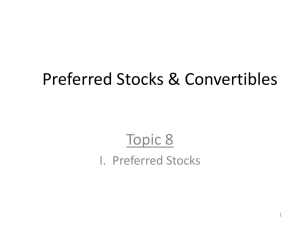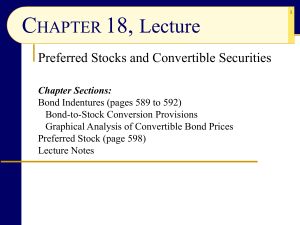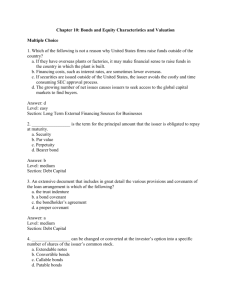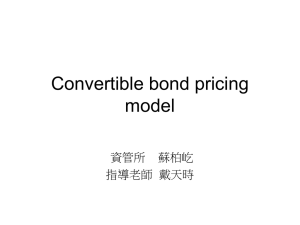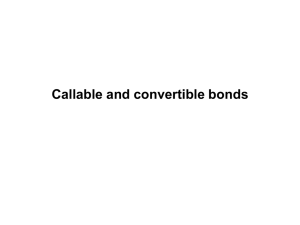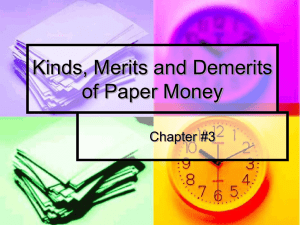Chapter 50
advertisement
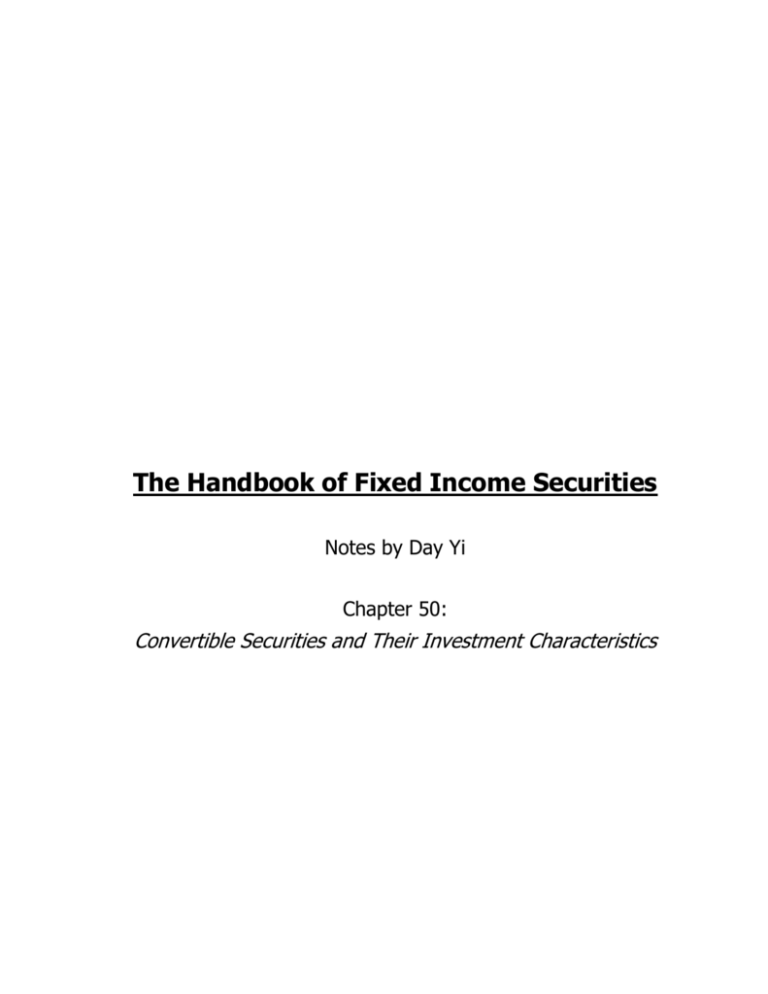
The Handbook of Fixed Income Securities Notes by Day Yi Chapter 50: Convertible Securities and Their Investment Characteristics The Handbook of Fixed Income Securities 116102657 I. INTRODUCTION A. Convertible securities are fixed income securities that permit the holder the right to exchange that security for the common stock of the issuing corporation under pre-specified conditions B. The terms at which the debt security can be exchanged for the issuer’s common stock are set forth in the security’s indenture C. Convertible securities typically contain other embedded options 1. Most common is an option providing the issuer the right to call the issue at its discretion in accordance with the terms set forth in the indenture 2. Many convertible securities also contain put provisions, which enable the holder to redeem the bond prior to maturity II. GENERAL CHARACTERISTICS OF CONVERTIBLES A. Convertible bonds are often subordinated debentures 1. This means that the claims of “senior” creditors must be settled in full before any payment will be made to holders of subordinated debentures in the event of insolvency or bankruptcy 2. Senior creditors typically include holders of all other long-term debt issues and bank loans 3. Subordinated debentures have a priority over preferred and common stock B. Structurally, a convertible bond is very similar to a straight corporate bond with an attached call option on the stock C. Convertible preferred stocks are equity type securities which offer 1. A priority to dividend payments over common stock 2. Higher payments than common 3. The opportunity to share in corporate growth, albeit at a slower rate than the common D. The value of a convertible security is related to many variables 1. Price of the underlying stock (+) 2. Interest rates (-) 3. Credit quality (+) 4. Volatility of the stock price (+) 5. Volatility of interest rates (-) E. The ideal convertible bond renders 1. A bond-like return if the return on the underlying issuer’s stock is minimal or negative 2. An equity-like return if the underlying stock’s return is quite positive F. The convertible provides the investor with the “better of” return profile 1. The yield on convertible bonds is lower than the yield on the more senior debt of the same issuer 2. The cumulative yield sacrificed represents a payment for the conversion privilege 3. Normally, the convertible bond yield will exceed the dividend yield of the stock 4. The cost of the stock, when purchased through the conversion rights, will exceed the price at which the common stock could have been purchased by the premium paid 2/12/2016 1 The Handbook of Fixed Income Securities 116102657 5. The premium will vary upon issuance but will approximate 25% for a well-balanced convertible bond G. There are many varieties of convertible securities in the market 1. The main factor distinguishing the various types of securities is the degree of equity-like association H. Convertible bonds are issued in many countries and denominated in many currencies III. ADVANTAGES AND DISADVANTAGES TO ISSUING FIRMS A. The issuance of convertibles, relative to nonconvertibles, offers the advantage of 1. Lower interest cost 2. Less restrictive covenants B. A nonconvertible issue will require a yield to maturity that is higher than that offered by a convertible issue C. The issuer of a convertible bond is confronted with capital structure uncertainty 1. The decision to issue a convertible bond is a hybrid, uncertain capital structure decision a. In the extreme, the issuer is faced with the worst of two worlds i. If the firm’s business prospects sour, the choice of a convertible bond rather than equity will have proven to be a bad one because bankruptcy risk will have increased considerably ii. If the business booms and the common stock price accelerates substantially, the firm’s convertible bonds will be converted to equity and existing shareholders’ share of the growth is diluted b. The choice of a convertible bond is a bet by the firm that its business is more stable than that implied by the market’s assessment of firm-specific volatility c. The firm incurs lower marginal financing costs and fewer restrictions while accepting the possibility of having to “pay-up” in common stock in the future d. The bottom line is that the company usually knows more about its particular financial attributes than the market meaning that corporate financing decisions may provide important signals to the market IV. ADVANTAGES TO THE INVESTOR A. An investor purchasing a convertible security receives the advantages of a more senior security 1. The safety of principal (prior claim to assets over equity security holders) 2. Relative income stability at a known interest rate B. When underlying common stock rises or declines in price 1. If the common stock of the issuer rises in price, the convertible will usually also rise allowing the investor to realize a gain through sale in the secondary market of the convertible without conversion into the stock 2. If the common stock of the issuer declines in price, the bond can be expected to decline no lower in price than where it yields a satisfactory return on its value as a straight bond 3. A convertible offers the downside protection that bonds can offer during bad economic times, while allowing one to share in the upside potential for the common stock of a growing firm C. Convertible bonds typically offer higher current yield than do common stocks 2 2/12/2016 The Handbook of Fixed Income Securities 116102657 1. If the dividend yield on the underlying common stock surpassed the current yield on the convertible bond, conversion would tend to become more attractive 2. All else equal, increases in the dividend yield are detrimental to the value of the convertible bond D. Convertible bonds may be a particularly attractive asset class for investors whose ability to take equity risk is constrained 1. Because convertible bonds are in fact bonds, they may be an ideal asset for a constrained investor who desires more equity risk 2. They offer downside protection afforded by the bond and the upside potential of the equity risk 3. This investor may construct a bond portfolio with an “equity kicker” component through the use of convertible securities V. DISADVANTAGES TO THE INVESTOR A. A premium to bond value for the conversion privilege by accepting a significantly lower yield than that offered by nonconvertible bonds of equivalent quality B. The potential inverse association between the convertible bond’s yield spread and the issuer’s stock price VI. ALTERNATIVE FORMS OF CONVERTIBLE FINANCING A. High coupon B. Putable securities C. Callable securities D. Exchangeable securities E. Zero coupon F. Premium redemption price VII. TYPES OF CONVERTIBLE INVESTORS A. Defensive equity managers — convertibles offer the possibility of being defensive through their downside protection, while still pursuing the growth potential associated with common-stock investment. B. Equity managers seeking income — desire a higher level of income than currently being provided by common stocks, while maintaining the potential of sharing in the growth of the firm through the embedded warrant on the underlying equity; some growth potential is sacrificed because convertibles typically sell at a premium to the underlying equity value C. Convertible specialists — specialize in the management of convertible securities D. Bond portfolio managers — sacrifice income to obtain a limited exposure to the growth potential and risks associated with an option on the underlying common stock E. Arbitrageurs and hedgers — short common stock against long convertible bond position and hope to profit from changes in valuation and volatility; tend to participate in the in-the-money part of the universe F. Insurance companies — invest in convertible bonds to achieve a greater exposure to the equity market without increasing capital requirements; tend to participate in the at-the-money part of the universe VIII. 2/12/2016 FACTORS TO BE CONSIDERED WHEN EVALUATING CONVERTIBLE SECURITIES 3 The Handbook of Fixed Income Securities 116102657 A. Appreciation in price of the common stock that is required before conversion could become attractive as measured by the conversion premium B. Prospects for growth in the price of the underlying stock C. Downside price risk in the event that the conversion privilege proves valueless D. Ultimate credit quality of the issuer, which helps define the stability of the bond floor E. Probability of greater than anticipated volatility in the price of the underlying common stock F. Special provisions and covenants (callability, putability) IX. AN ILLUSTRATIVE ANALYSIS A. Conversion ratio and price 1. A conversion ratio directly specifies the number of shares of the issuing firm’s common stock that can be obtained by surrendering the convertible security 2. A conversion price is the price paid per share to acquire the underlying common stock through conversion 3. The conversion ratio may be determined by dividing the stated conversion price into the par value of the security 4. The security contract may provide for changes in the conversion price over time B. Zero-Coupon Convertible Bonds (Hewlett-Packard) 1. Generally, have 20 years to maturity 2. Are issued at a fraction of par value 3. Redemption at 100% of par provides yield 4. Most have 3 to 5 years of call protection 5. Most offer an option to put the bond back to the issuer at the first call date and a couple of dates after 6. Call and put strike prices for the same dates are matched at accreted values 7. Have no yield advantage over underlying equities 8. Premium is determined by the value of the embedded equity put option with a sliding up strike price (at the first put date the strike is lower than that at maturity) C. Conversion Premium 1. The conversion premium ratio shows the percentage increase necessary to reach a parity price relationship between the underlying common stock and the convertible a. Conversion parity is that price relationship between the convertible and the common stock at which neither a profit nor a loss would be realized by purchasing the convertible, converting it, and selling the common shares that were received in conversion, ignoring commissions 2. There is usually, but not always, some conversion premium present on convertibles, which reflects the anticipation of a possible increase in the price of the underlying common stock beyond the parity price D. Yield Sacrifice 1. It is the price appreciation potential for the underlying common stock and the quality of the bond floor that are most important 4 2/12/2016 The Handbook of Fixed Income Securities 116102657 E. Downside Risk Potential 1. The floor price for a convertible is estimated as that value at which the instrument would sell in the market to offer the yield of an equivalent nonconvertible instrument 2. The bond floor represents the insurance inherent to a convertible bond F. Breakeven Time 1. Breakeven time represents the number of years it will take for the favorable income differential over the common stock offered by the convertible to equal the total dollar conversion premium paid to acquire the convertible on a per share basis 2. Breakeven time is a crude method for measuring the value of a convertible security a. It is a measure of the amount of time it takes to pay for the option premium but ignores the actual value of the equity option b. All else equal, we expect that the more volatile the underlying stock, the greater the premium and breakeven time G. Scenario Analysis 1. “Dynamic” implies that the yield spread of the bond and the volatility of the stock are both integrally related to the movement of the stock 2. Price movements of the stock are assumed independent of the market interest rate changes 3. A convertible security may fare poorly when the stock falls sharply (Winstar Communications 7% Preferred) 4. The importance of credit quality and credit analysis to convertible bond portfolio management H. Separate Asset Class 1. Upon issuance, the convertible is neither a stock nor a bond 2. It is only after the fact that one can conclude about its ultimate character 3. Because this is true and because not all stocks go up together (nor do they change at a constant rate), the correlation of the performance of the convertible bond universe to bonds and stocks varies considerably but predictably 4. Convertible securities should be considered a separate asset class 5. The investor in a convertible bond has a great advantage over the holder of a nonconvertible corporate bond of the same issuer a. Management of many companies have engaged in leveraged stock-buy back programs at the expense of the debt holders and to the benefit of stockholders and option holders (like management itself) b. Though not likely, capital structure changes initiated by management that reduce leverage tend to help bond holders c. I. Because convertible bondholders participate in both bond and stock movements, the investors cannot be a target of management Call Risk 1. The call will limit the potential gain on the convertible if the stock moves substantially to the upside J. 2/12/2016 Putable Convertibles 5 The Handbook of Fixed Income Securities 116102657 K. Dilution of the Conversion Privilege 1. A large common stock split or stock dividend could markedly dilute the value of the conversion privilege, unless adjustment of the number of shares received in conversion is made X. DURATION MANAGEMENT A. The importance of duration to convertible bond management varies as a function of the price of the equity relative to the conversion price 1. The greater this ratio, the less the importance of duration management 2. At low ratios, convertible bonds approach straight corporate bond status and duration management is most important B. Effective duration, which accounts for the effect of the embedded options, is the important bond management metric for duration management XI. VALUATION OF CONVERTIBLES A. An investor in a convertible security effectively owns 1. A nonconvertible fixed income security and 2. A call option on the issuer’s common stock B. The value of a convertible bond disregarding the conversion feature is called its straight value C. The value of a convertible bond, if it is converted immediately into the common stock of the issuer, is called its conversion value 1. This value is found by multiplying the conversion ratio by the current market price of the common stock D. The minimum value of a convertible bond is the greater of its straight value and conversion value 1. Arbitrage ensures that this will occur E. A convertible bond will trade at a premium above the minimum value because of the value of the option the security holder has 1. It is usually very difficult to infer precise values because a. The convertible bonds are generally subordinate to the senior debt and b. The covenants in the indenture are different 2. The option component always has a value even if it is way out of the money 3. At any common stock price, the difference between the actual price and the minimum price is the value of the option F. Determining the worth of the option to buy the common stock embedded in a convertible bond is complicated 6 2/12/2016
